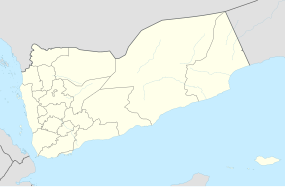Zafar, Yemen
| Ẓafār | |
| Location | Ibb, Yemen |
|---|---|
| Coordinates | 14°12′41″N 44°24′31″E / 14.21139°N 44.40861°E |
| Type | settlement |
| Length | 1200m |
| Width | 1000m |
| Area | 110 ha |
| Height | 2800 m |
| History | |
| Builder | Himyarite |
| Material | stone |
| Founded | 2nd? century BCE |
| Abandoned | 6th century CE |
| Periods | Himyarite |
| Cultures | South Arabia |
| Associated with | today 450 |
| Site notes | |
| Excavation dates | 1998–2009 |
| Archaeologists | Paul Yule |
| Condition | badly plundered |
| Ownership | public |
| Management | GOAM |
| Public access | presently inaccessible |
Ẓafār or Dhafar (Ar ظفار) Ðafār (museum: UTM: 435700E, 1571160 N zone 38P, 14°12'N, 44°24'E, deviating slightly from Google Earth) is an ancient Himyarite site situated in Yemen, some 130 km south-south-east of today's capital, Sana'a. Given mention in several ancient texts, there is little doubt about the pronunciation of the name. Despite the opinion of local patriots in Oman, this site in the Yemen is far older than its namesake there. It lies in the Yemenite highlands at some 2800 m. The closest large town is Yarim, which is 10 km directly to the north-north-west. Zafar was the capital of the Himyarites (110 BCE - 525 CE), which at its peak ruled most of the Arabia. The Himyar are not a tribe, but rather a tribal confederacy. For 250 years the confederacy and its allies combined territory extended past Riyadh to the north and the Euphrates to the north-east. Zafar was the Himyarite capital in Southern Arabia prior to the Aksumite conquest.
Archaeologically speaking, the settlement's beginnings are not well known. The main sources consist of Old South Arabian musnad inscriptions dated as early as the 1st century BCE. It is mentioned by Pliny in his Natural History, in the anonymous Periplus of the Erythraean Sea (both 1st century CE), as well as in the Geographia of Claudius Ptolemaeus (original 2nd century CE). At some point, presumably the medieval times the coordinates of the Ptolemy map were incorrectly copied or emended so that subsequent maps place the site Sephar metropolis in Oman, not in the Yemen. The Zafar in Yemen is more than 1000 years older than that place-name in Oman, assuming from the evidence in known texts (Smith 2001: 380). Written sources regarding Zafar are numerous, but heterogeneous in informational value. The most important source is epigraphic Old South Arabian. Christian texts shed light on the war between the Himyar and the Aksumites (523 - 525). The Vita of Gregentios is a pious forgery created by Byzantine monks, which mentions a bishop who allegedly had his see in Zafar. It contains linguistic usage possibly of the 12th century CE.
...
Wikipedia

